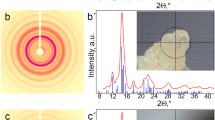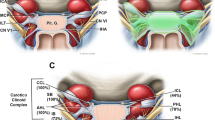Abstract
Background
There are several reports about the microanatomical and histological features of sellar and parasellar membranous structures and clinical studies about MMP proteinase as a predictive factor. However, studies on collagen contents of sellar and parasellar membranous structures are limited. We demonstrated the membranous structures surrounding the pituitary gland and defined extracellular matrix (ECM) collagenous proteins, collagen I-IV expression patterns of sellar and parasellar connective tissues.
Methods
The study was carried out on ten fresh postmortem human bodies at the Forensic Medicine Institution. Cavernous sinuses were resected with sellar structures and were stored at −80°C liquid nitrogen tanks. Medial wall of the cavernous sinus, pituitary capsule and pituitary tissue samples were obtained for RT-PCR. Opposite side specimens were used for histological and immune staining studies. Collagens I-IV were studied by immunohistochemical and reverse transcription polymerase chain reaction (RT-PCR) methods.
Findings
The pituitary capsule and medial wall were identified as two different structures. The fibrous membrane, as the third membrane, was identified as staying whole in eight of ten specimens. Increased type IV collagen was determined in the pituitary gland, medial wall and pituitary capsule, respectively, in both RT-PCR and immunhistochemical studies. Immunhistochemical studies revealed that collagen I was strongly expressed in both the medial wall and pituitary gland.
Conclusion
Increased type IV collagen was detected especially in pituitary tissue, the medial wall and the pituitary capsule by immune staining and RT-PCR. Type IV collagen was considered to be an important factor in the progression of adenoma and invasion.









Similar content being viewed by others
References
Abuzayed B, Tanriover N, Gazioglu N, Ozlen F, Cetin G, Akar Z (2010) Endoscopic anatomy and approaches of the cavernous sinus: cadaver study. Surg Radiol Anat 32(5):499–508
Asa SL, Ezzat S (2009) The pathogenesis of pituitary tumors. Annu Rev Pathol 4:97–126
Ballin M, Comez SE, Sinha CC, Thorgeirsson UP (1998) Ras oncogene mediated induction of a 92 kDa metalloproteinase; strong correlation with the malignant phenotype. Biochem Biophys Res Commun 154:823–838
Beaulieu E, Kachra Z, Mousseau N, Delbecchi L, Hardy J, Béliveau R (1999) Matrix metalloproteinases and their inhibitors in human pituitary tumors. Neurosurgery 45(6):1432–1441
Bernhard ED, Gruber SB, Muschel RJ (1994) Direct evidence linking expression of matrix metalloproteinase 9 (92-kDa gelatinase/ collagenase) to the metastatic phenotype in transformed rat embryo cells. Proc Natl Acad Sci USA 91:4293–4297
Cavallo LM, Cappabianca P, Galzio R, Iaconetta G, de Divitiis E, Tschabitscher M (2005) Endoscopic transnasal approach to the cavernous sinus versus transcranial route: anatomic study. Neurosurgery 56(2 Suppl):379–389
Ceylan S, Koc K, Anik I (2010) Endoscopic endonasal transsphenoidal approach for pituitary adenomas invading the cavernous sinus. J Neurosurg 112(1):99–107, Erratum in (2010) J Neurosurg.;112(1):210
Ceylan S, Anik I, Koc K (2011) A new endoscopic surgical classification and invasion criteria for pituitary adenomas involving the cavernous sinus. Turk Neurosurg 21(3):330–339
Chi JG, Lee MH (1980) Anatomical observations of the development of the pituitary capsule. J Neurosurg 52:667–670
Ciric I (1977) On the origin and nature of the pituitary gland capsule. J Neurosurg 46:596–600
Destrieux C, Kakou MK, Velut S, Lefrancq T, Jan M (1998) Microanatomy of the hypophyseal fossa boundaries. J Neurosurg 88:743–752
Dietemann JL, Kehrli P, Maillot C, Diniz R, Reis M Jr, Neugroschl C, Vinclair L (1998) Is there a dural wall between the cavernous sinus and the pituitary fossa? Anatomical and MRI findings. Neuroradiology 40:627–630
Dolenc VV (1989) Relation of the cavernous sinus to the sella. In: Dolenc VV (ed) Anatomy and surgery of the cavernous sinus. Springer, Vienna, pp 118–130
Dolenc VV (1989) Anatomy and surgery of the cavernous sinus. Springer, Heidelberg Tokyo Berlin
Dolenc VV (1997) Transcranial epidural approach to pituitary tumors extending beyond the sella. Neurosurgery 41:542–550
Dolenc VV, Rogers L (2003) Microsurgical anatomy and surgery of the central skull base. Springer, Wien, p 43
Ezzat S, Asa SL (2006) Mechanisms of disease: the pathogenesis of pituitary tumors. Nat Clin Pract Endocrinol Metab 2(4):220–230
Frank G, Pasquini E (2006) Endoscopic endonasal cavernous sinüs surgery, with special reference to pituitary adenomas. Front Horm Res 34:64–82
Gong J, Zhao Y, Abdel-Fattah R, Amos S, Xiao A, Lopes MB, Hussaini IM, Laws ER (2008) Matrix metalloproteinase-9, a potential biological marker in invasive pituitary adenomas. Pituitary 11(1):37–48
Horikawa T, Yoshizaki T, Sheen TS, Lee SY, Furukawa M (2000) Association of latent membrane protein 1 and matrix metalloproteinase 9 with metastasis in nasopharyngeal carcinoma. Cancer 89:715–723
Hua J, Muschel R (1996) Inhibition of matrix metalloproteinase 9 expression by a ribozyme blocks metastasis in a rat sarcoma model system. Cancer Res 56:5279–5284
Isono M, Inoue R, Kamida T, Kobayashi H, Matsuyama J (2003) Significance of leptin expression in invasive potential of pituitary adenomas. Clin Neurol Neurosurg 105:111–116
Kawamoto H, Uozumi T, Arita K, Yano T, Hirohata T (1996) Type IV collagenase activity and cavernous sinus invasion in human pituitary adenomas. Acta Neurochir (Wien) 138:390–395
Knappe UJ, Fink T, Fisseler-Eckhoff A, Schoenmayr R (2010) Expression of extracellular matrix-proteins in perisellar connective tissue and dura mater. Acta Neurochir (Wien) 152(2):345–353
Kong YG, Su CB, Ren ZY, Wang RZ, Li GL, Dou WC, Zhang B, Tian SQ (2003) Measurement of soluble CD44v6 in peripheral blood as assistant diagnosis of invasive pituitary adenomas. [Abstract]. Zhongguo Yi Xue Ke Xue Yuan Xue Bao 25:698–701
Laquerriere A, Yun J, Hemet JTJ, Tadie M (1993) Experimental evaluation of bilayered human collagen as a dural substitute. J Neurosurg 78:487–491
Nakajima M, Welch D, Wynn D, Tsuruo Y, Nocolson G (1993) Serum and plasma M(r) 92,000 progelatinase levels correlate with spontaneous metastasis of rat 13762NF mammary adenocarcinoma. Cancer Res 53:5802–5807
Peker S, Kurtkaya-Yapicier O, Kiliç T, Pamir MN (2005) Microsurgical anatomy of the lateral walls of the pituitary fossa. Acta Neurochir (Wien) 147(6):641–648
Pfaffl MW, Horgan GW, Dempfle L (2002) Relative expression software tool (REST) for group-wise comparison and statistical analysis of relative expression results in real-time PCR. Nucleic Acids Res 30:e36
Songtao Q, Yuntao L, Jun P, Chuanping H, Xiaofeng S (2009) Membranous layers of the pituitary gland: histological anatomic study and related clinical issues. Neurosurgery 64(3 Suppl):1–9
Takino H, Herman V, Weiss M, Melmed S (1995) Purine-binding factor (nm23) gene expression in pituitary tumors: marker of adenoma invasiveness. J Clin Endocrinol Metab 80:1733–1738
Thapar K, Scheithauer BW, Kovacs K, Pernicone PJ, Laws ER (1996) p53 expression in pituitary adenomas and carcinomas: correlation with invasiveness and tumor growth fractions. Neurosurgery 38(4):765–771
Trouillas J, Daniel L, Guigard MP, Tong S, Gouvernet J, Jouanneau E, Jan M, Perrin G, Fischer G, Tabarin A, Rougon G, Figarella-Branger D (2003) Polysialylated neural cell adhesion molecules expressed in human pituitary tumors and related to extrasellar invasion. J Neurosurg 98:1084–1093
Watanabe H, Nakanishi I, Yamashita K, Hayakawa T, Okada Y (1993) Matrix metalloproteinase-9 (92 kDa gelatinase/type IV collagenase) from U937 monoblastoid cells: correlation with cellular invasion. J Cell Sci 104:991–999
Werner JA, Rathcke IO, Mandic R (2002) The role of matrix metalloproteinases in squamous cell carcinomas of the head and neck. Clin Exp Metastasis 19:275–282
Yasuda A, Campero A, Martins C, Rhoton AL Jr, Ribas GC (2004) The medial wall of the cavernous sinus: microsurgical anatomy. Neurosurgery 55(1):179–189
Yilmazlar S, Kocaeli H, Aydiner F, Korfali E (2005) Medial portion of the cavernous sinus: quantitative analysis of the medial wall. Clin Anat 18(6):416–422
Yokoyama S, Hirano H, Moroki K, Goto M, Imamura S, Kuratsu JI (2001) Are nonfunctioning pituitary adenomas extending into the cavernous sinus aggressive and/or invasive? Neurosurgery 49(4):857–862
Zucker S, Lysik RM, Zarrabi MH, Moll U (1993) M(r) 92,000 type IV collagenase is increased in plasma of patients with colon cancer and breast cancer. Cancer Res 53:140–146
Conflicts of interest
None.
Author information
Authors and Affiliations
Corresponding author
Additional information
Comment
In this interesting article, Ceylan and co-workers defined the microsurgical anatomy of membranous layers of the pituitary gland and expression levels of extracellular matrix (ECM) collagenous proteins.
Indeed, they collected a conspicuous series of data showing the high concentration of type IV collagen, especially in adenohypophysis, medial wall and pituitary capsule. The most interesting consideration concerns the relationship between the role of the metalloproteinase-9 (type IV collagenase) in the ECM degradation, as a part of a possible control mechanism of type IV collagen concentration in the medial wall of cavernous sinus and pituitary capsule, determining the grade of tumor invasiveness. The degradation of ECM proteins, in fact, is required as a crucial part of tumor invasion pathway and type IV collagenase, i.e., MMP-9, seems to play a pivotal role in this proteolytic process. Indeed, the identification of its expression could have a critical relevance in the management of lesions extending into the cavernous sinus, representing a predicting factor of tumor invasiveness.
Paolo Cappabianca
Michelangelo De Angelis
Napoli, Italy
The authors have undertaken an interesting study examining the type of collagen in the pituitary, pituitary capsule and medial wall of the cavernous sinus. They have utilized both immunostaining for protein expression and RT-PCR. Demonstration of the presence of type IV collagen in the roof, pituitary capsule and medial wall of the cavernous sinus is a potentially important finding, in that the presence of this collagen may enhance the invasion of adenomas which may secrete MMP9 (type IV collagenase). This is an interesting hypothesis; in addition to providing insight into the mechanism of tumor invasion, this also may provide a target for therapy. The authors are to be congratulated on their paper, which should stimulate further work by these and other workers in the field.
William T. Couldwell
Utah, USA
Rights and permissions
About this article
Cite this article
Ceylan, S., Anik, I., Koc, K. et al. Microsurgical anatomy of membranous layers of the pituitary gland and the expression of extracellular matrix collagenous proteins. Acta Neurochir 153, 2435–2443 (2011). https://doi.org/10.1007/s00701-011-1182-3
Received:
Accepted:
Published:
Issue Date:
DOI: https://doi.org/10.1007/s00701-011-1182-3




